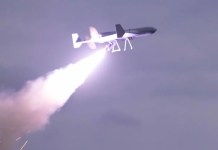Weeks after British PM Boris Johnson’s pledge to make the UK the foremost naval power in Europe, defense ministry officials have confirmed that London will buy more than the 48 carrier-capable F-35B jets that are already on order.
China Trying To Convert Taiwan Into Next Hong Kong – Taiwan FM
Air Marshal Richard Knighton, the deputy chief of the defense staff for capability, told the parliamentary defense committee that the number and profile of future order will in part be decided by the outcome of assessment work the British are doing on their future combat air strategy.
Admitting the need to increase the number of F-35Bs to support the [Royal Navy] carrier, Knighton said “the precise number will depend a bit on the work we do and the investment we are making on the Future Combat Air System (FCAS)”, referring to the UK-led Tempest program.
The fighter jet’s short take-off-and-vertical-landing (STOVL) capability allows it to operate from the new ‘Queen Elizabeth’-class aircraft carriers. Considered Lockheed Martin’s ultimate crown jewel alongside the American exclusive F-22 Raptors, the F-35 Lightning II is a single-seat, single-engine, all-weather stealth multirole fighter capable of performing ground attacks and air defense missions.

The F-35b jets are principally scheduled to equip the two new 65,000-tonne aircraft carriers of the Royal Navy. Britain was originally to buy 138 of Lockheed Martin’s STOVL combat jets. Knighton told the committee that the number could be more or less than 138, but they need an analysis to get the right number.
As per the plans, the HMS Queen Elizabeth is set to be deployed for its first operational mission in the Indian Ocean with British and US Marine Corps F-35Bs onboard. While the ship can operate with up to 72 jets at a squeeze, but initially due to the lack of resources, only some 24 jets are expected to be the full complement of fighters on board.
Of the 48 jets on order, the British navy has so far received 21 lightning fighters and the remaining aircraft would be delivered by 2025. Britain has plans to field the F-35B in both land and maritime-based roles, but the priority is to reconstitute the Royal Navy’s carrier strike capability.
Our next 3 F-35B Lightning II aircraft have departed the @LockheedMartin factory flown by pilots from @OC617Sqn and @OC207Sqn. This increases the UK fleet to 21 F-35s thanks to @DefenceES @theF35JPO and many others. Looking forward to their arrival in the UK over the coming days. pic.twitter.com/BkpkV30fhP
— AOC 1 Gp (@AlMarshallRAF) November 27, 2020
From 2023 onwards, the British will be able to operate up to 24 aircraft. Knighton said that some funding has to be allocated “if want to order aircraft to be delivered in the later part of the decade”.
The permanent secretary at the MoD Sir Stephen Lovegrove told the committee that while it was certain Britain would order more jets it wouldn’t be anytime soon. He ensured that talks are underway but they haven’t reached the contract stage.
Recently, after announcing a £16 billion increase in MoD funding over the four years starting in April 2021, PM Boris Johnson said, “We shall use our extra defense spending to restore Britain’s position as the foremost naval power in Europe, taking forward our plans for eight Type 26 and five Type 31 frigates, and support ships to supply our carriers”.
Author’s Profile: https://eurasiantimes.com/author/ab-aakriti-sharma-zn/
Email: aakrits8@gmail.com
Follow EurAsian Times on Google




